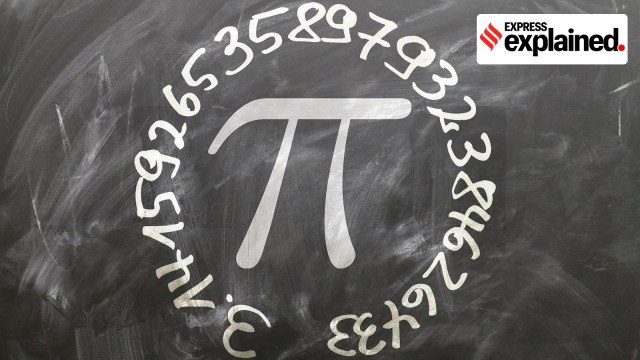- India
- International
Behind the world’s most famous mathematical constant — Pi
What is pi? How is it calculated? And why do we care so much about it?
 With the power of modern computers, mathematicians have calculated Pi up tp 31 trillion decimal places. (Pixabay)
With the power of modern computers, mathematicians have calculated Pi up tp 31 trillion decimal places. (Pixabay)March 14, or 3/14 as per the American convention, is celebrated as Pi Day worldwide as an ode to the most well-known approximation (3.14) of the mathematical constant Pi.
The tradition was started by physicist Larry Shaw of the Exploratorium museum in San Francisco in 1988, and has since seen global popularity. On the day, mathematicians try to raise awareness on their subject among lay persons, through lectures, museum exhibitions and pie (sic) eating competitions.
In 2019, UNESCO’s 40th General Conference designated Pi Day as the International Day of Mathematics.
What is Pi?
Pi, often represented by the Greek letter π, is the most famous of all mathematical constants. It represents the ratio of a circle’s circumference (boundary) to its diameter (a straight line between two points on the circle’s boundary, passing through its centre). Regardless of the circle’s size, this ratio always remains constant.
 Pie-eating competions are a popular part of United States’ Pi Day traditions. (Wikimedia Commons/Representational)
Pie-eating competions are a popular part of United States’ Pi Day traditions. (Wikimedia Commons/Representational)
Pi is an irrational number — it is a decimal with no end and no repeating pattern — which is most often approximated to the 3.14, or the fraction 22/7.

How is Pi calculated?
The importance of Pi has been recognized for at least 4,000 years. Petr Beckman in his classic, A History of Pi (1970), wrote that “by 2,000 BC, men had grasped the significance of the constant that is today denoted by π, and that they had found a rough approximation of its value.”
Both ancient Babylonians and ancient Egyptians came up with their own measurements, probably by drawing a circle of some diameter, and then measuring its circumference using a rope of said diameter in length. Babylonians settled at 25/8 (3.125) as the value of Pi, while ancient Egyptians settled at (16/9)^2 (approximately 3.16).
It was Greek polymath Archimedes (circa 287-212 BCE) who came up with the method to calculate Pi that remained in use till the 17th century. He realised that the perimeter of a regular polygon of ‘n’ sides inscribed in a circle is smaller than the circumference of the circle, whereas the perimeter of a similar polygon circumscribed around the circle is greater than its circumference. He used this to calculate the limits within which the value of Pi must lie.
 This, in principle, is how Archimedes arrived at the approximate value of Pi. Notably, he started with a hexagon (6-sided polygon), then doubled the number of sides till he reached a 98-sided polygon. (Wikimedia Commons)
This, in principle, is how Archimedes arrived at the approximate value of Pi. Notably, he started with a hexagon (6-sided polygon), then doubled the number of sides till he reached a 98-sided polygon. (Wikimedia Commons)
Now, as one keeps adding more and more sides to this polygon, it gets closer and closer to the shape of a circle. Having reached 96-sided polygons, Archimedes proved that 223/71 < Pi < 22/7 (in decimal notation, this is 3.14084 < π < 3.142858).
Following Archimedes, mathematicians constantly increased the number of sides of the polygon to calculate Pi to ever greater decimal places. By 1630, Austrian astronomer Christoph Grienberger calculated 38 digits of Pi using polygons with 10^40 sides.
The problem with this method, however, is that it is extremely labour intensive. For instance, it took Dutch mathematician Ludolph van Ceulen (1540-1610) a staggering three decades to calculate Pi to 35 decimal points.
It would be Isaac Newton (1643-1727) who significantly simplified the process of calculating Pi. In 1666, he calculated Pi up to 16 decimal places using calculus, which he discovered along with mathematician Gottfried Wilhelm Leibniz (1646-1713). What had taken previous mathematicians years to calculate now could be done in a matter of days.
By 1719, French mathematician Thomas Fantet de Lagny (1660-1734) had already calculated Pi up to 112 correct decimal places. Today, with the help of modern computers, this method has calculated the value of Pi up to 31 trillion (10^12) decimal places.
But why make all this effort?
Circles are everywhere in the world. So are three-dimensional shapes like cylinders, spheres, and cones, all of which carry the proportion of Pi. Knowing Pi’s value, thus, has some crucial practical benefits in the fields of architecture, design, and engineering. From constructing water storage tanks to fashioning hi-tech equipment for satellites, the value of Pi is indispensable in all sorts of areas.
Moreover, Pi seems to be woven into descriptions of the very deepest workings of the universe — from calculating the vastness of space or understanding the spiral of DNA. “Pi is often a key ingredient in the solution of a great many problems inspired by real-world phenomena… [it] will only increase its relevance as we continue to further our understanding of the world we live in,” Prof Dorina Mitrea, chair of the Department of Mathematics at Baylor University, Texas, told Newswise in 2023.
However, the calculation of Pi 31 trillion digits is less obviously “useful”. While Archimedes’ calculation was fairly adequate for all practical purposes that Pi was used for in his time, today, Pi needs to be calculated to about 39 decimal places in order to perform all calculations in the observable universe with virtually no error. Why then are mathematicians so fixated on the number?
There is of course the somewhat esoteric argument that knowledge, in and of itself, is valuable, regardless of what practical dividends it pays. But Pi is also alluring for other reasons. As mathematician Steven Strogatz, author of the award-winning The Joy Of X: A Guided Tour of Math, from One to Infinity (2012) wrote for The New Yorker in 2015: “The beauty of Pi, in part, is that it puts infinity within reach. Even young children get this. The digits of Pi never end and never show a pattern. They go on forever, seemingly at random—except that they can’t possibly be random, because they embody the order inherent in a perfect circle.”
More Explained
EXPRESS OPINION
May 08: Latest News
- 01
- 02
- 03
- 04
- 05











































